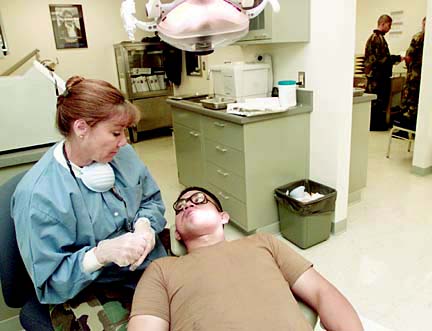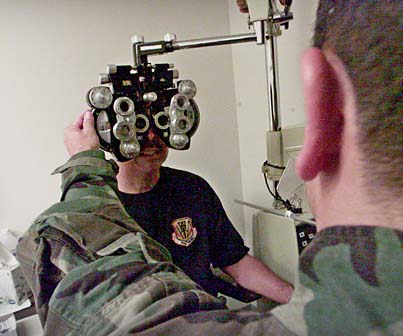
CINDY ELLEN RUSSELL / CRUSSELL@STARBULLETIN.COM
Dentist Maj. Betsy Lefebvre speaks with patient Christe Ramos about the importance of good dental hygiene at the 154th Medical Group Clinic at Hickam Air Force Base. Once a stationary unit, the medical group now is a mobile operation.
Hawaii Air Guard
seeks doctorsThe 154th Medical Group is looking
for surgeons and other medical specialists
Hawaii Air National Guard Col. Brett Wyrick is looking for trained doctors and emergency room technicians.
It's a tough task because of the island's shortage of doctors and other medical specialists and the increased demand by the Pentagon to put more reservists on active duty for longer periods of time.
The 154th Medical Group, which Wyrick commands at Hickam Air Force Base, needs a general surgeon, anesthesiologist, emergency room specialists and an orthopedic surgeon.
"There are no full-time doctors in the entire Air National Guard," said Wyrick, 43. "All of them are traditional guardsmen."
Wyrick, whose full-time job is a general surgeon in Hilo, has been a citizen soldier for the past 13 years. He said he realizes that new recruits will have to be doctors who belong to a medical group since it will be hard for sole practitioners to leave for extended periods.
This summer, when the 154th was converted to a group, its full-time staff doubled to eight and its part-time numbers nearly quadrupled to 119 people. The number of doctors climbed from five flight surgeons to 19 doctors.
CINDY ELLEN RUSSELL / CRUSSELL@STARBULLETIN.COM
Senior Master Sgt. Craig Harimoto looks through a phoropter during an eye exam with optometrist Lt. Col. Stanley Sato.
"There are 88 of these type of units in the entire Air National Guard," Wyrick said. "They are capable of providing emergency medical service to an Air Force wing of 2,500 to 3,000 people in a field environment for 30 days."
Because of technology, "we have become light, lean and mobile," he said.
The basic unit of the expeditionary medical support Air Force theater hospital can be carried on three pallets and brings with it 25 personnel. It contains four holding beds and can provide the basis for critical care, trauma resuscitation, heart attack revivals -- the full spectrum of combat medicine. Plug-in units keep building the basic medical support up to a 500-bed hospital.
Because the equipment will be lighter and faster, Air Force doctors will be able to care for their patients from the first aircraft in to the last one out.
For instance, Wyrick noted there is no longer heavy and bulky X-ray equipment and accompanying film and process equipment. "We now use digital X-rays, which cuts out a lot of equipment," he said.
"Where it used to take six C-5 jet cargo planes to move our medical equipment and supplies, now everything can be loaded onto one C-17 cargo plane," Wyrick said.
"This concept was tested during the floods in Houston three summers ago," he said. "We took the emergency medical service package out of San Antonio, flew into Houston, set it up in the Astrodome and in 13 hours, we were ready to do surgery."
"We can be fully functioning hospital within 72 hours, and with adequate airlift we can be anywhere in the world."
The potential of having such emergency medical service available in Hawaii and the Pacific is "a great concept," he said.
The entire medical service will be readily available to Maj. Gen. Robert Lee, who not only heads the National Guard here but also directs the state Civil Defense agency, Wyrick said.
"When another disaster like Hurricane Iniki strikes, General Lee doesn't have to go to anyone else for emergency medical service," Wyrick added. "He can take this emergency medical service and augment the civilian community. That is what I find to be very exciting."
Right now, Wyrick doesn't have all the medical equipment and supplies because they are being stockpiled on the mainland.
"We're trained, but we need to depend on the mainland to get the equipment here," said Wyrick, who is confident that with the help of the Federal Emergency Management Agency a change is in the works.
For medics like Staff Sgt. Evan Rhodes, who joined the Hawaii Guard during the first Gulf War because he "was mad at what Saddam Hussein was doing," things have never been better for the unit.
"We have a good commander," said Rhodes, who left a job as a city paramedic three years ago to sell real estate. "He's turned things around. We've just passed a major test. Morale at the unit is good. It's a good time."
Rhodes, 36, said his unit is instrumental to the Air Guard here. "We do all the physicals for the Air Guard," he said. "During wartime, our mission is like a M.A.S.H. unit, where we do everything from routine daily sick calls all the way up to major surgery."

